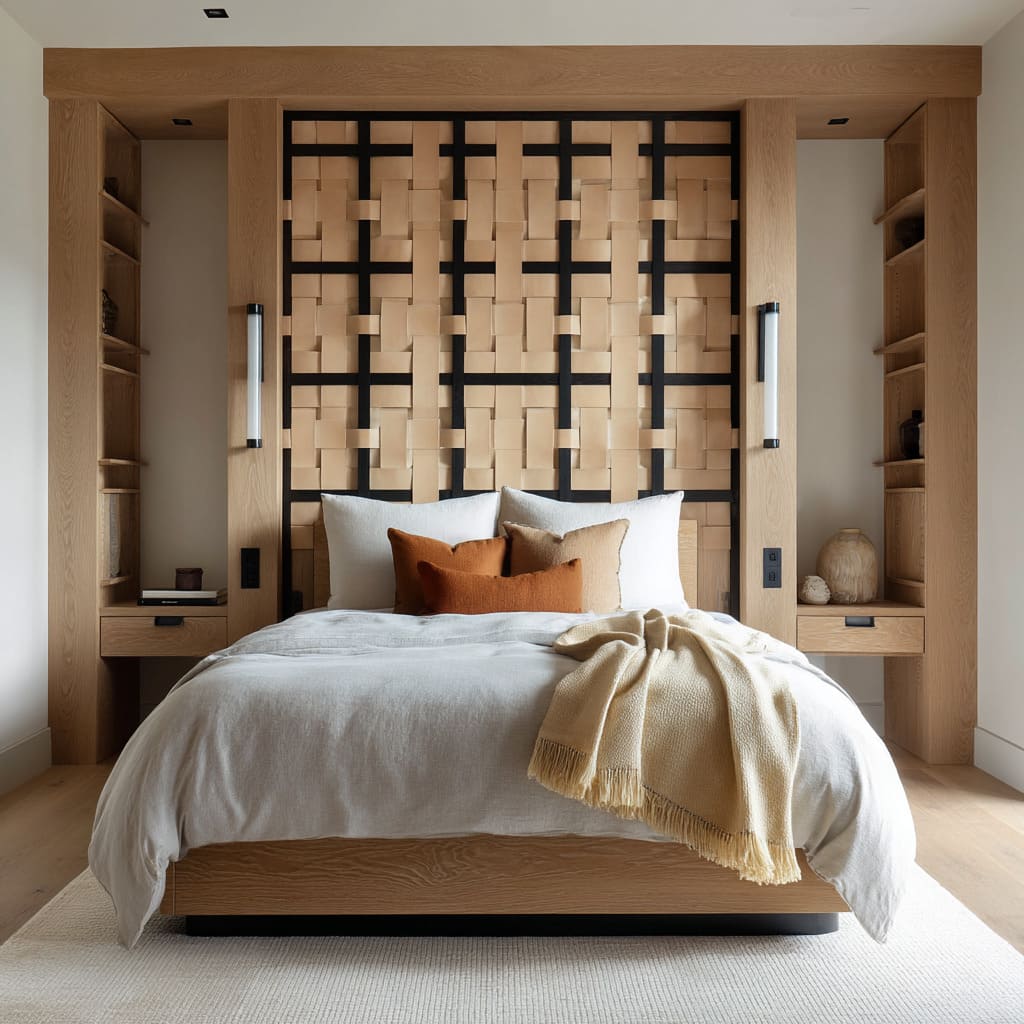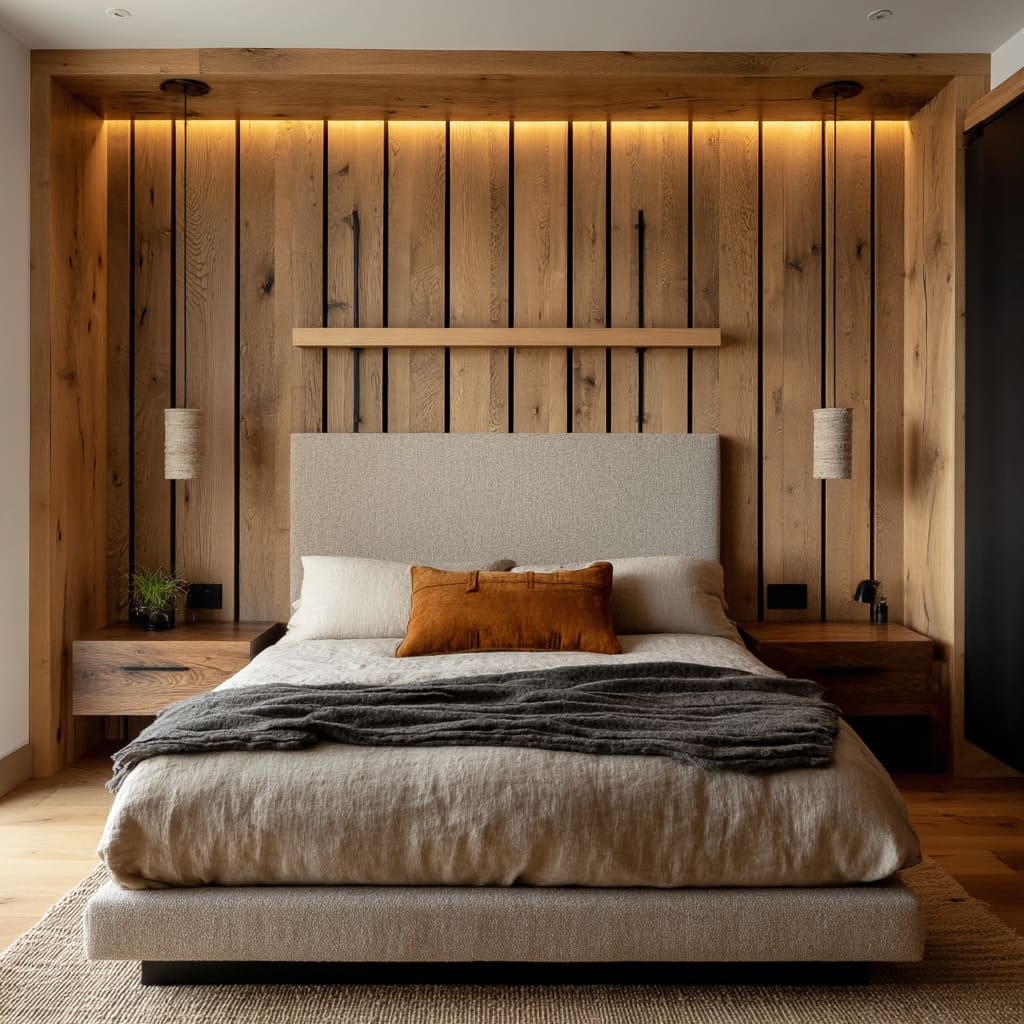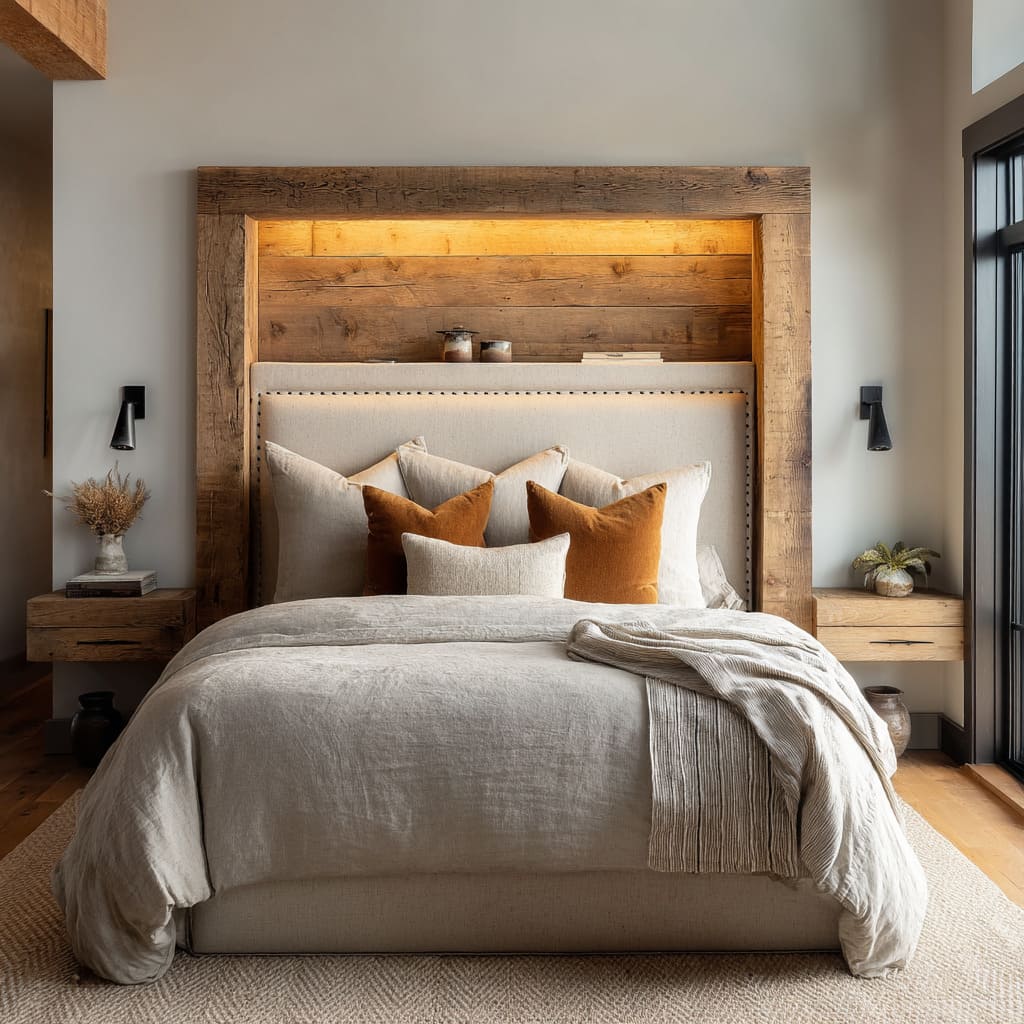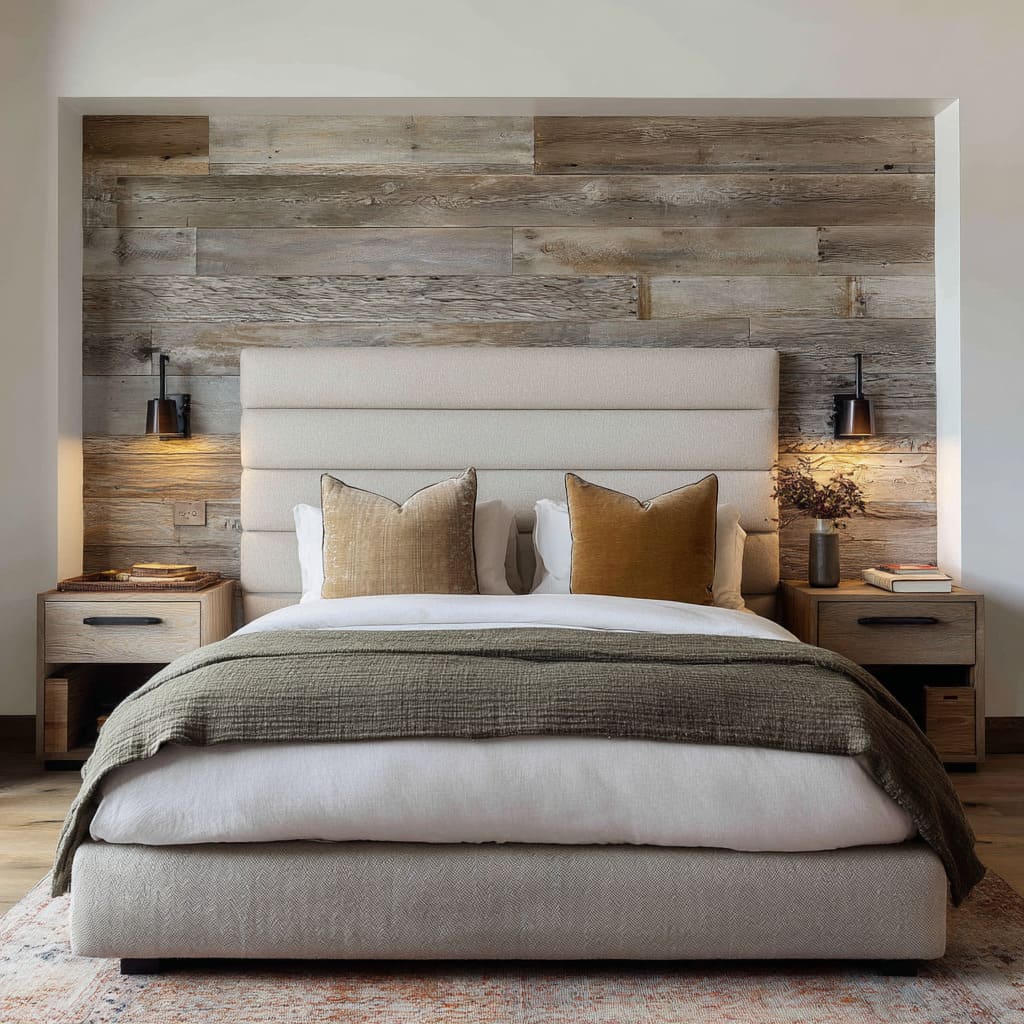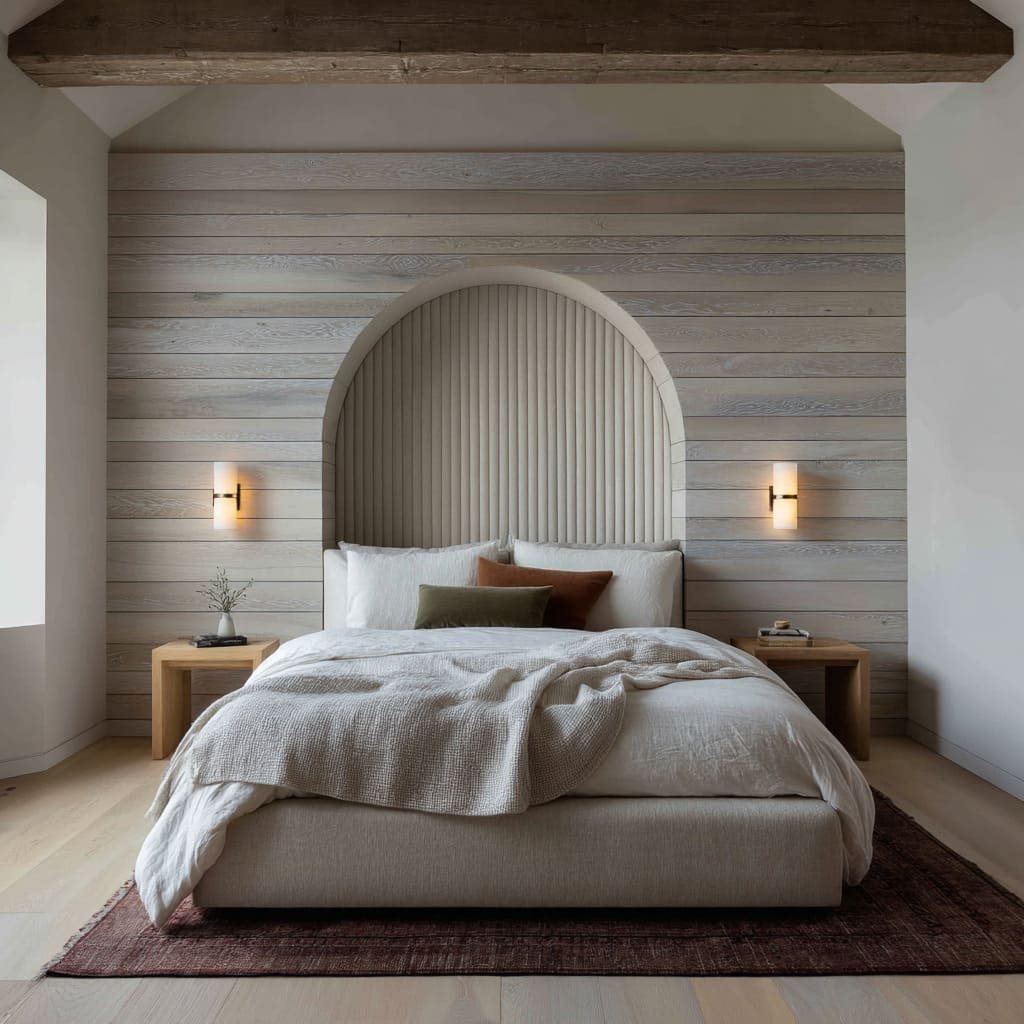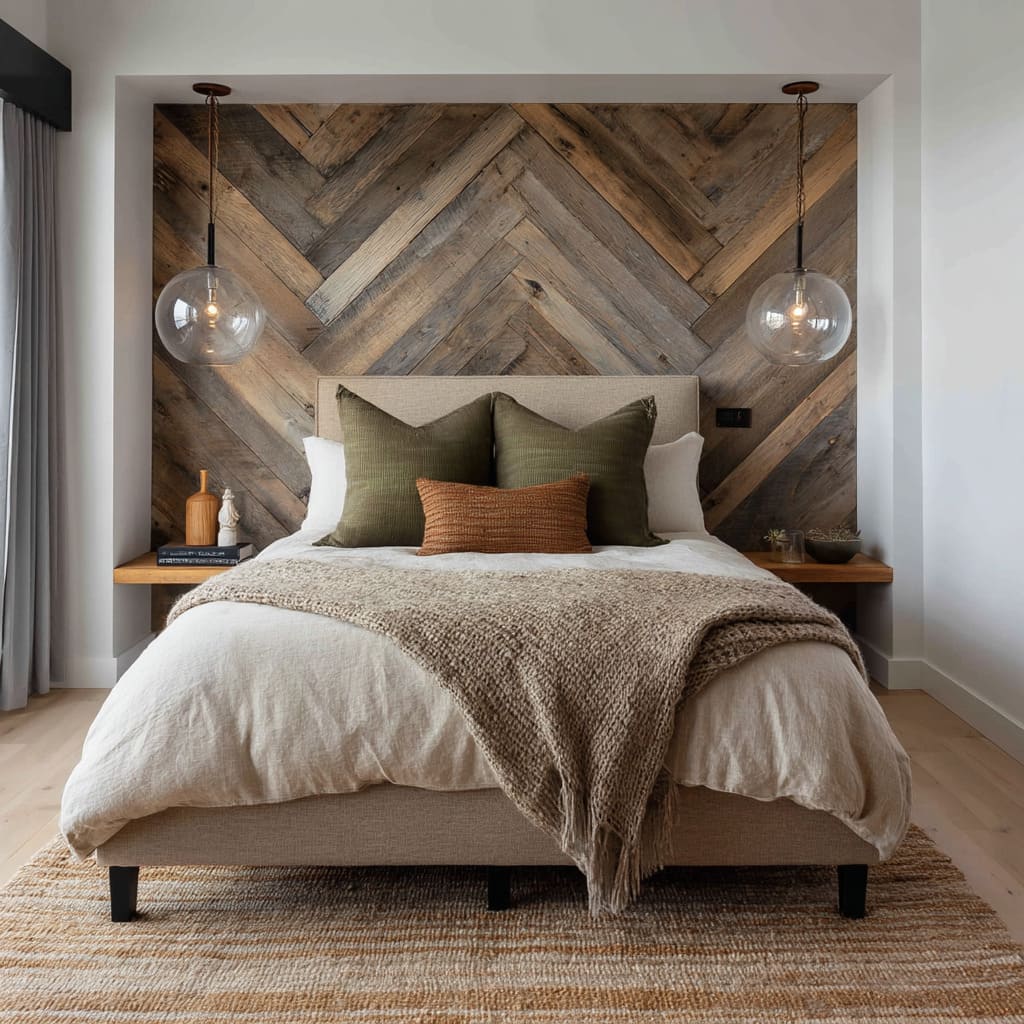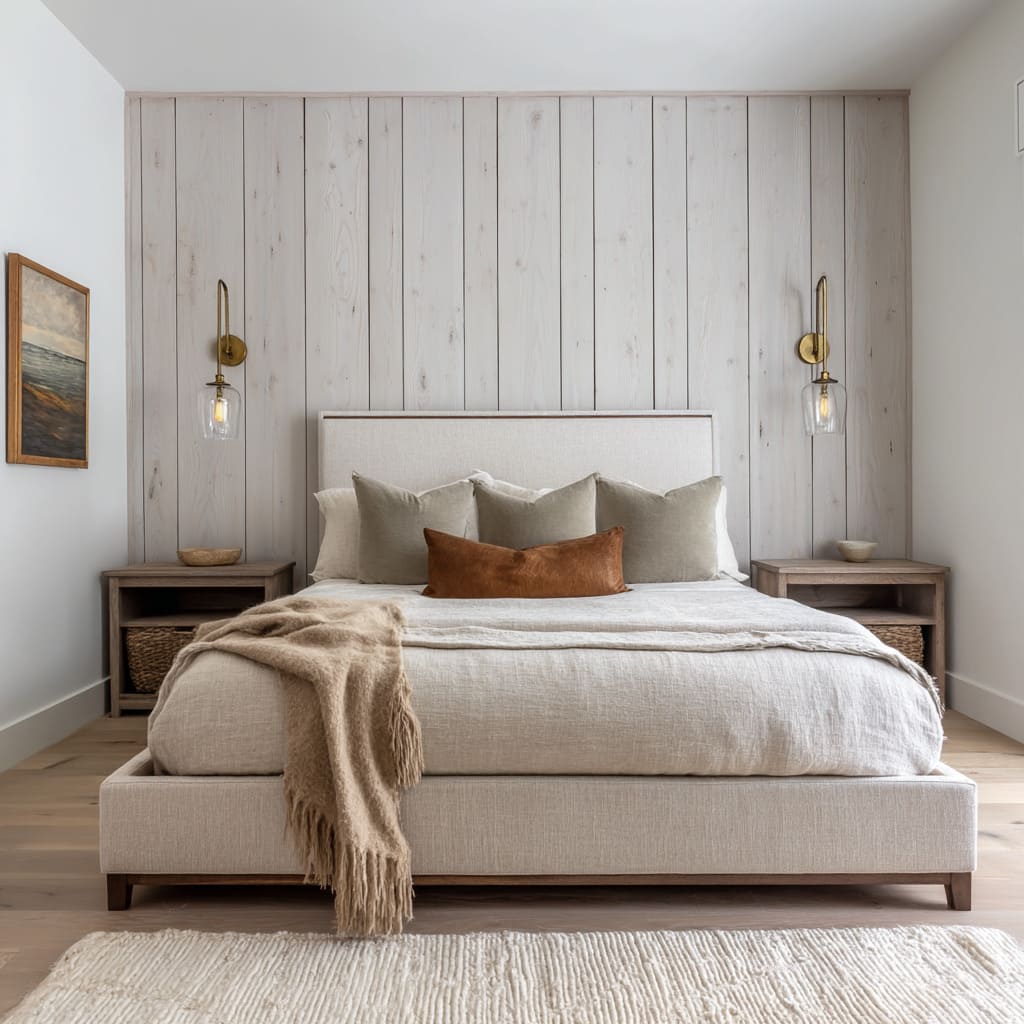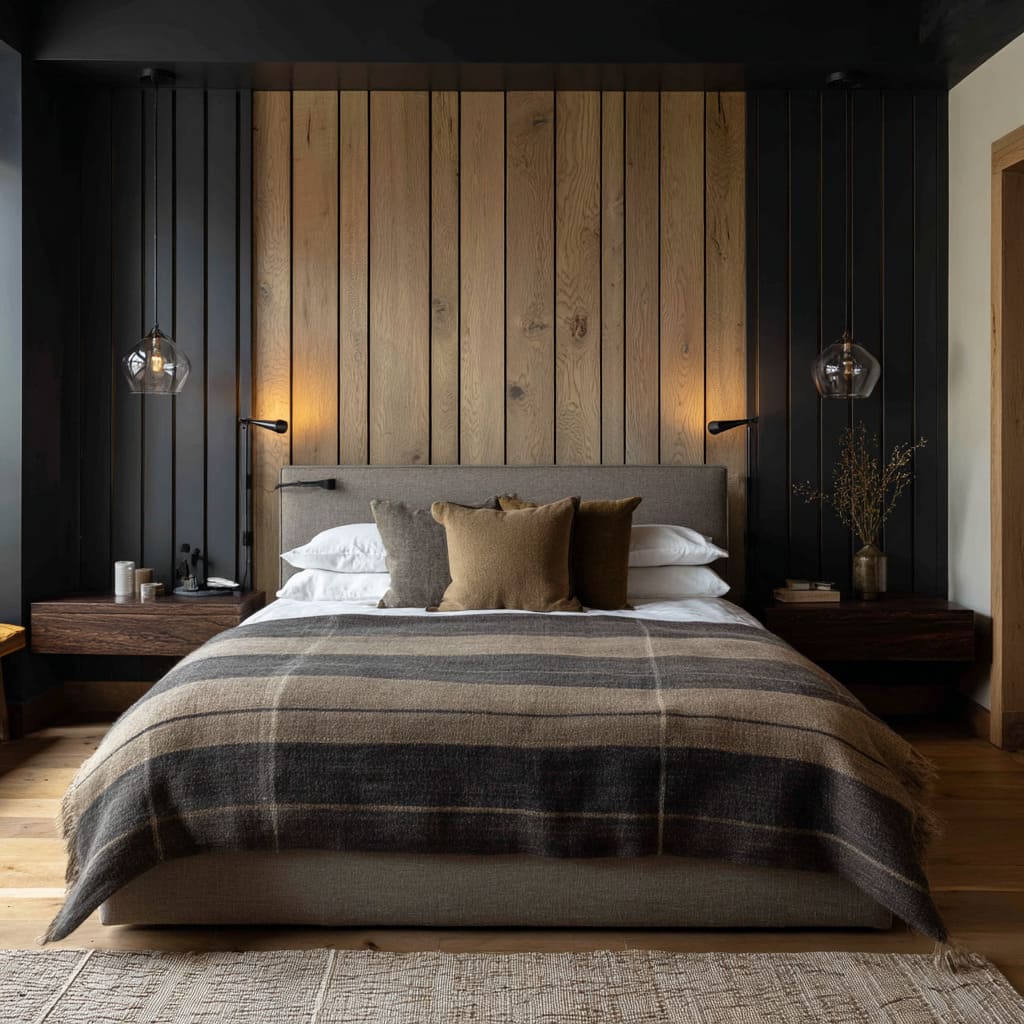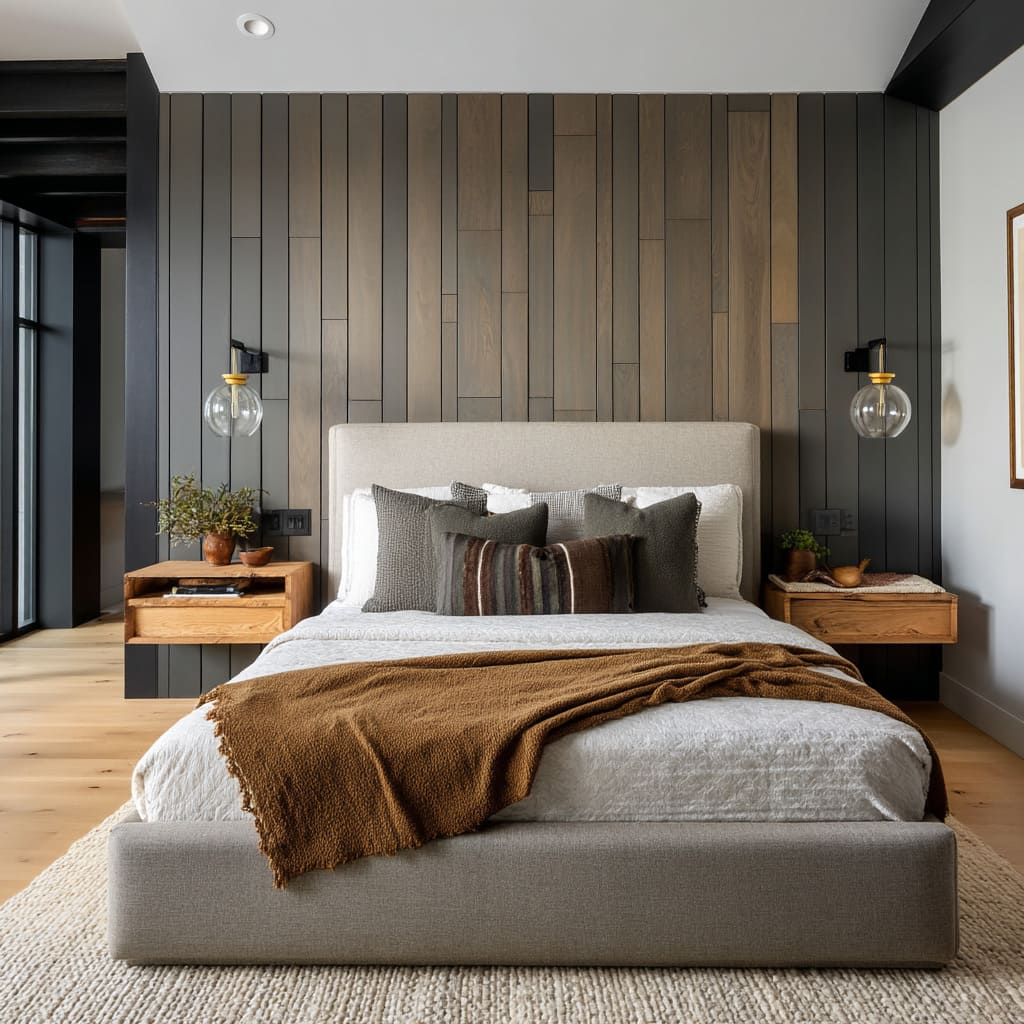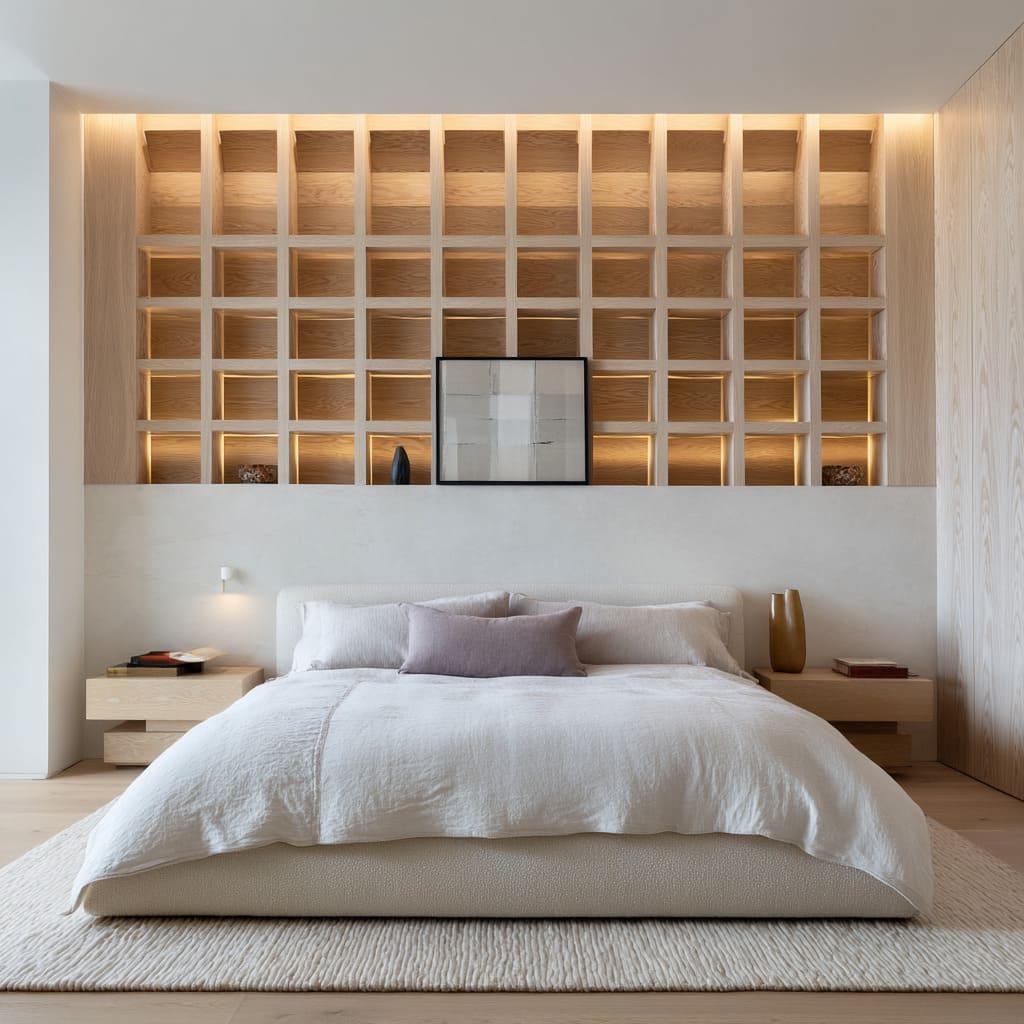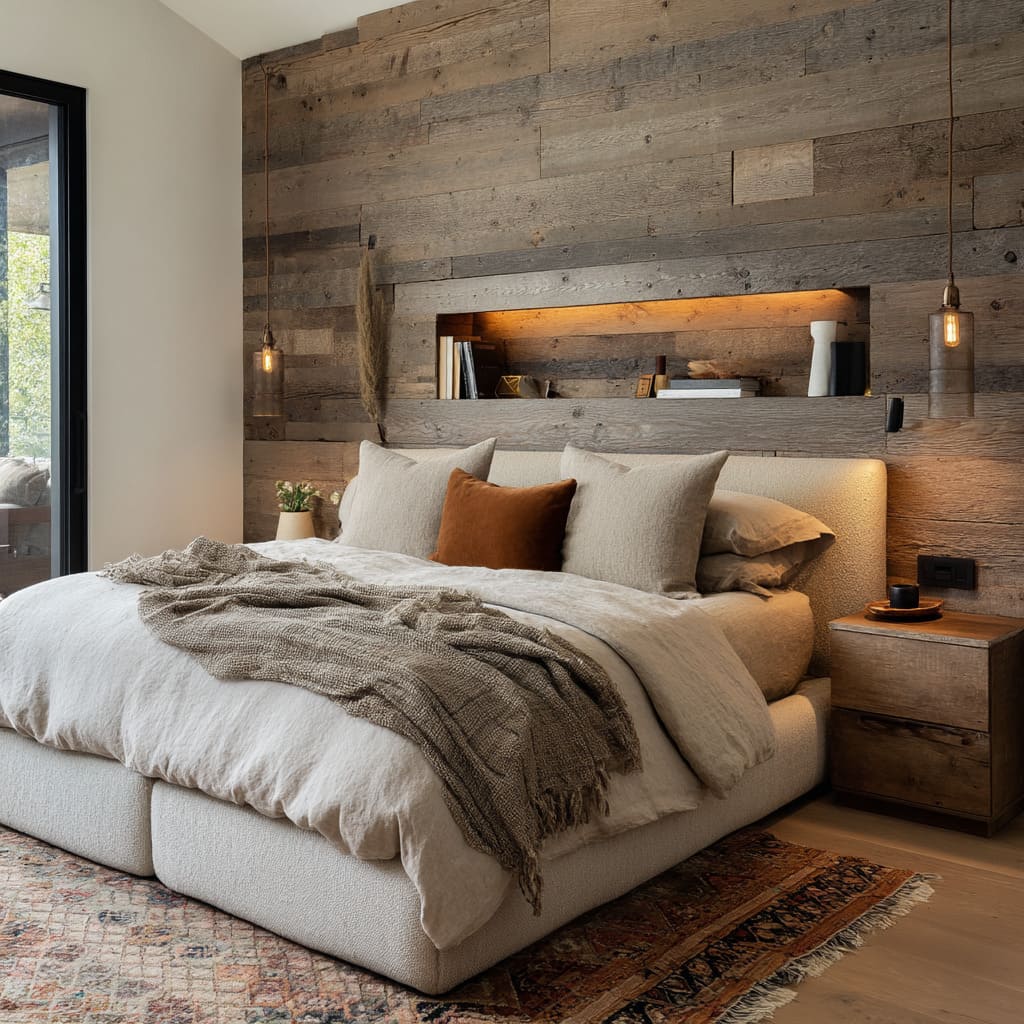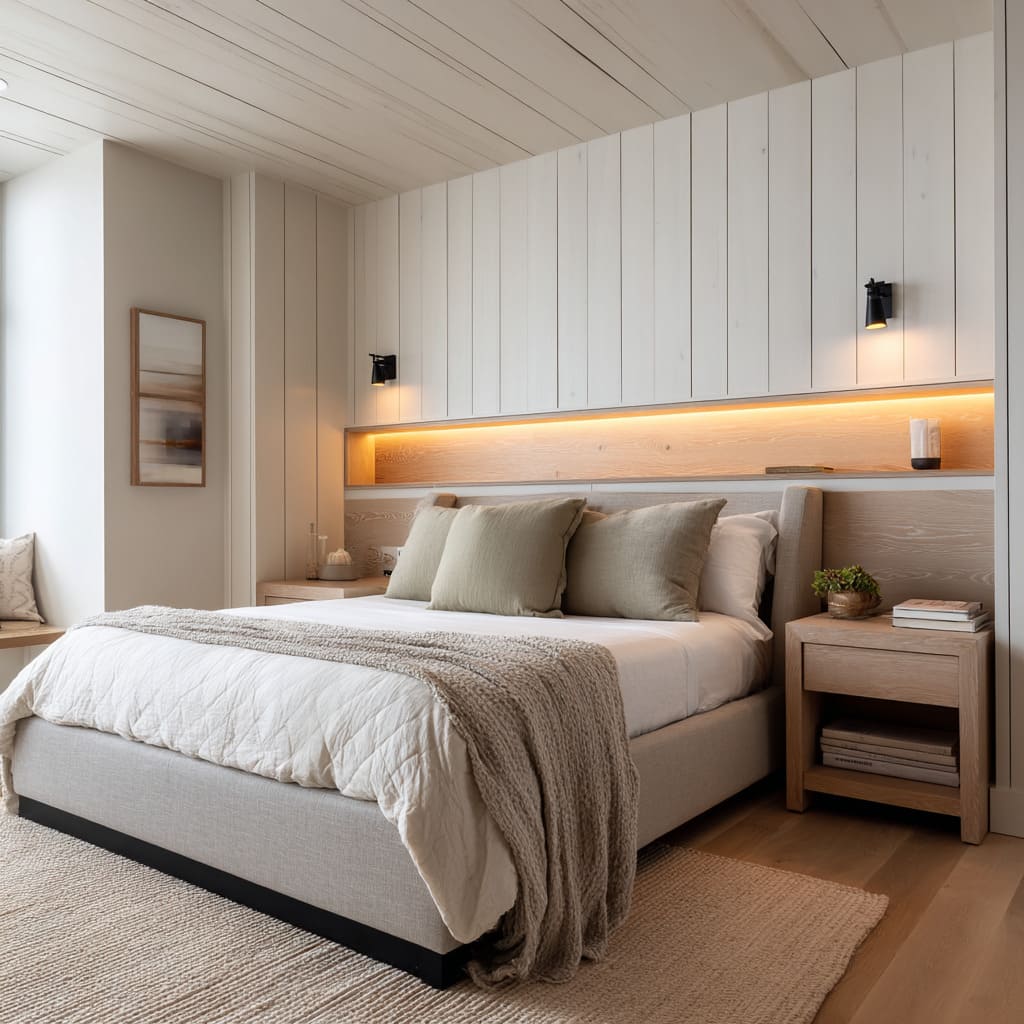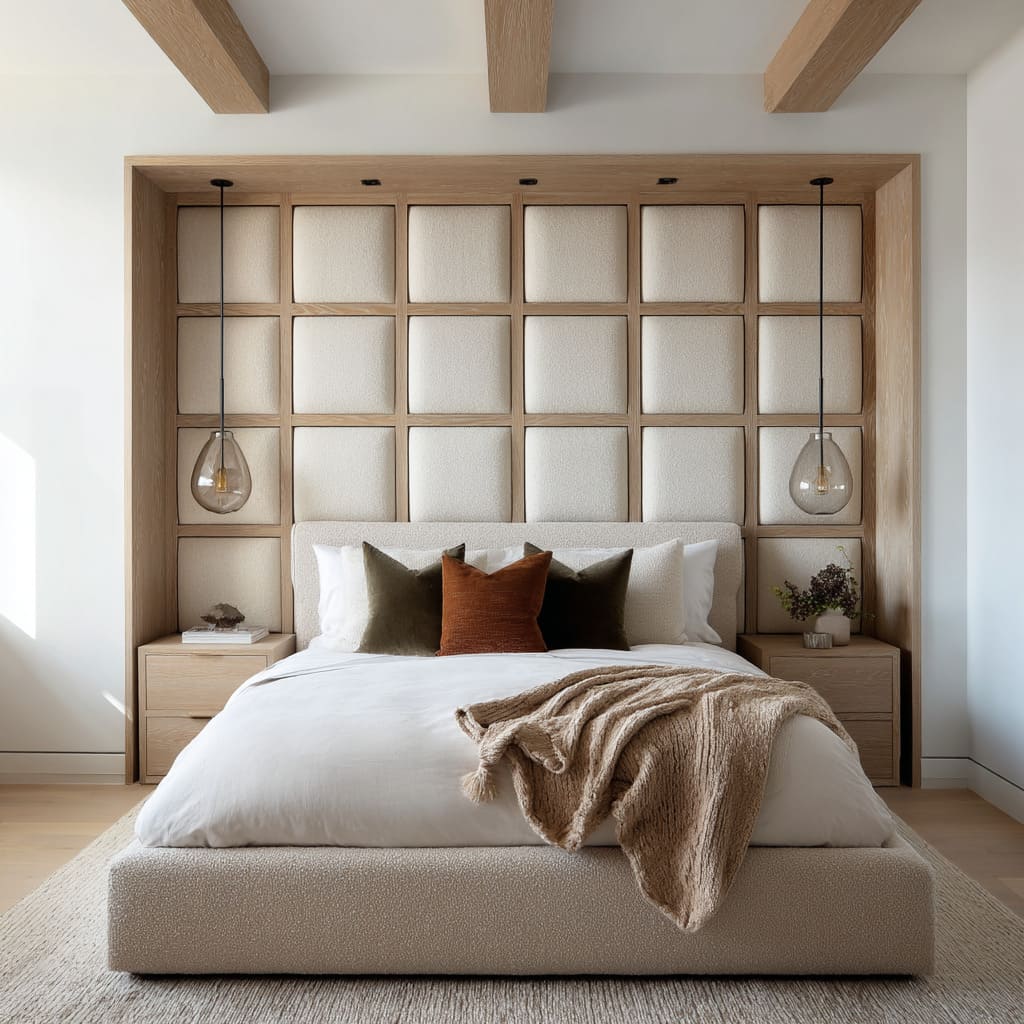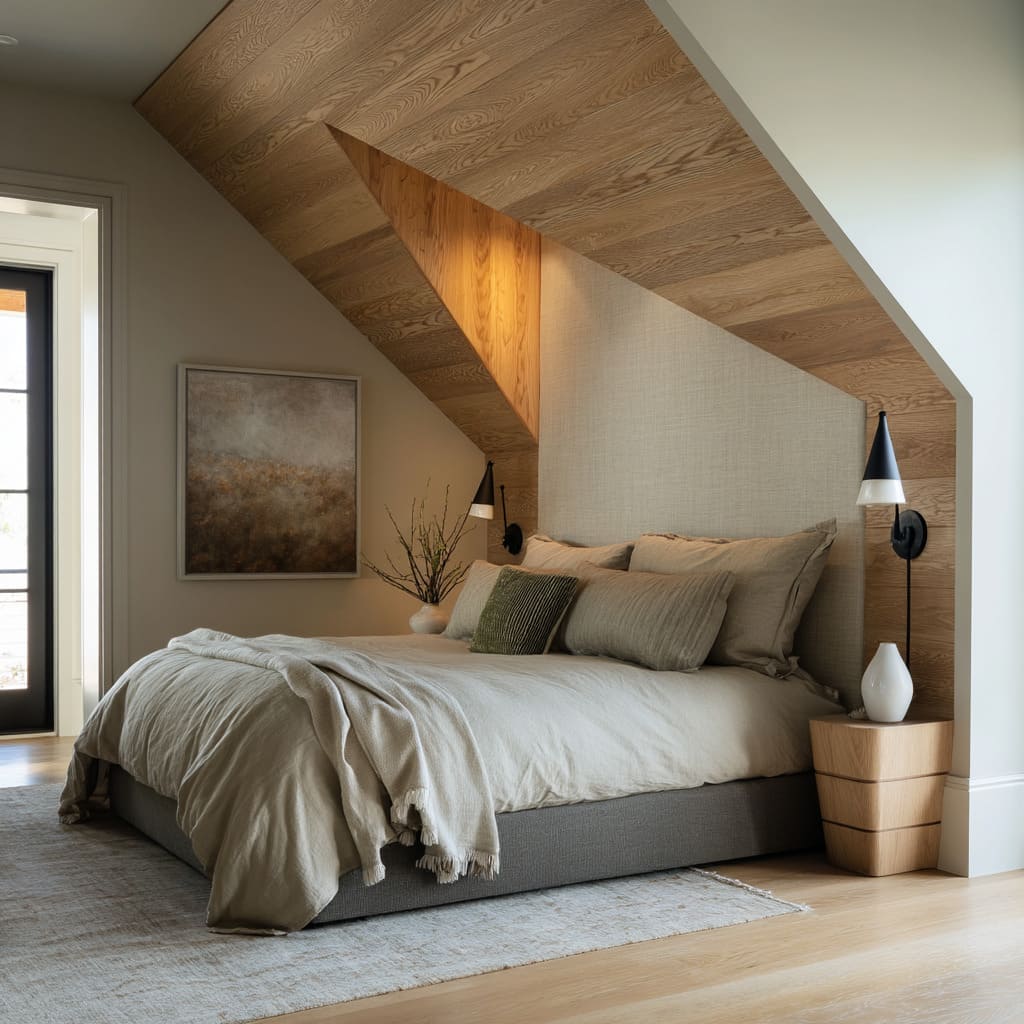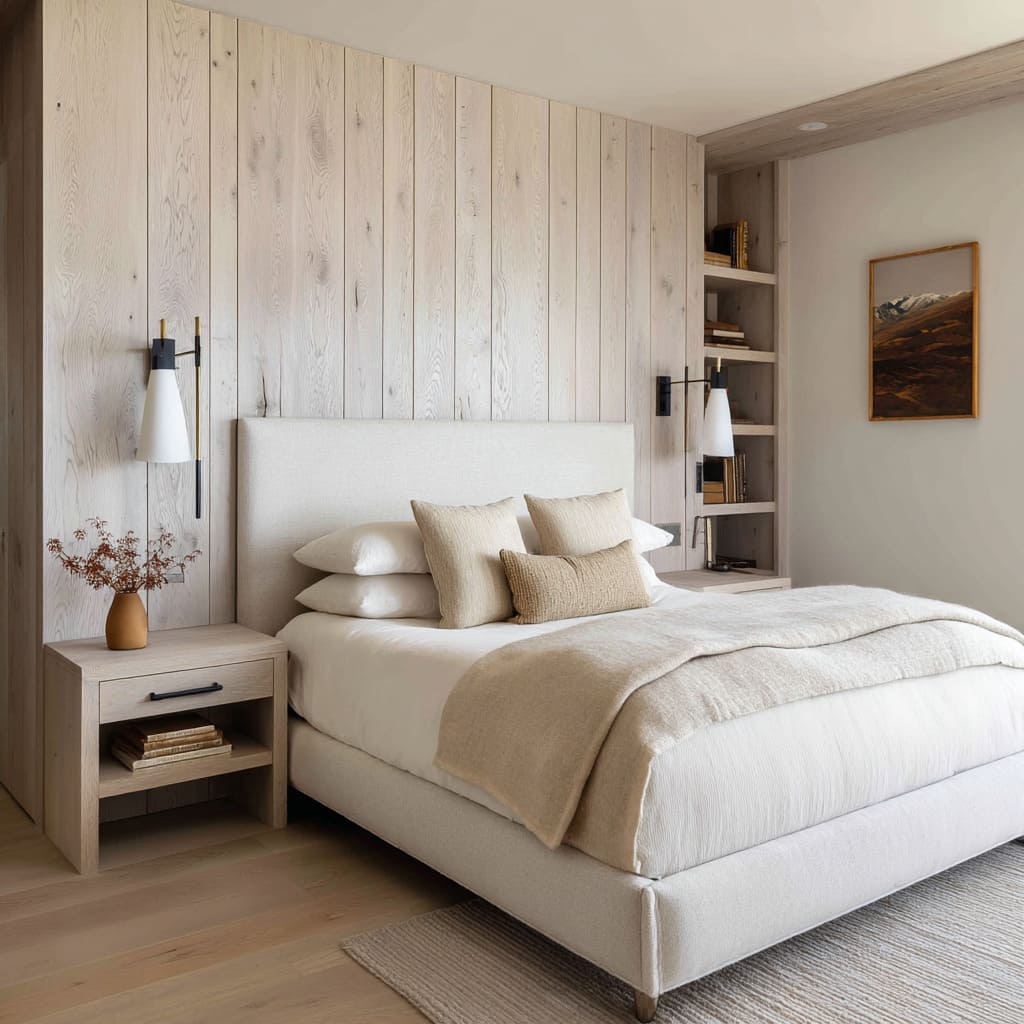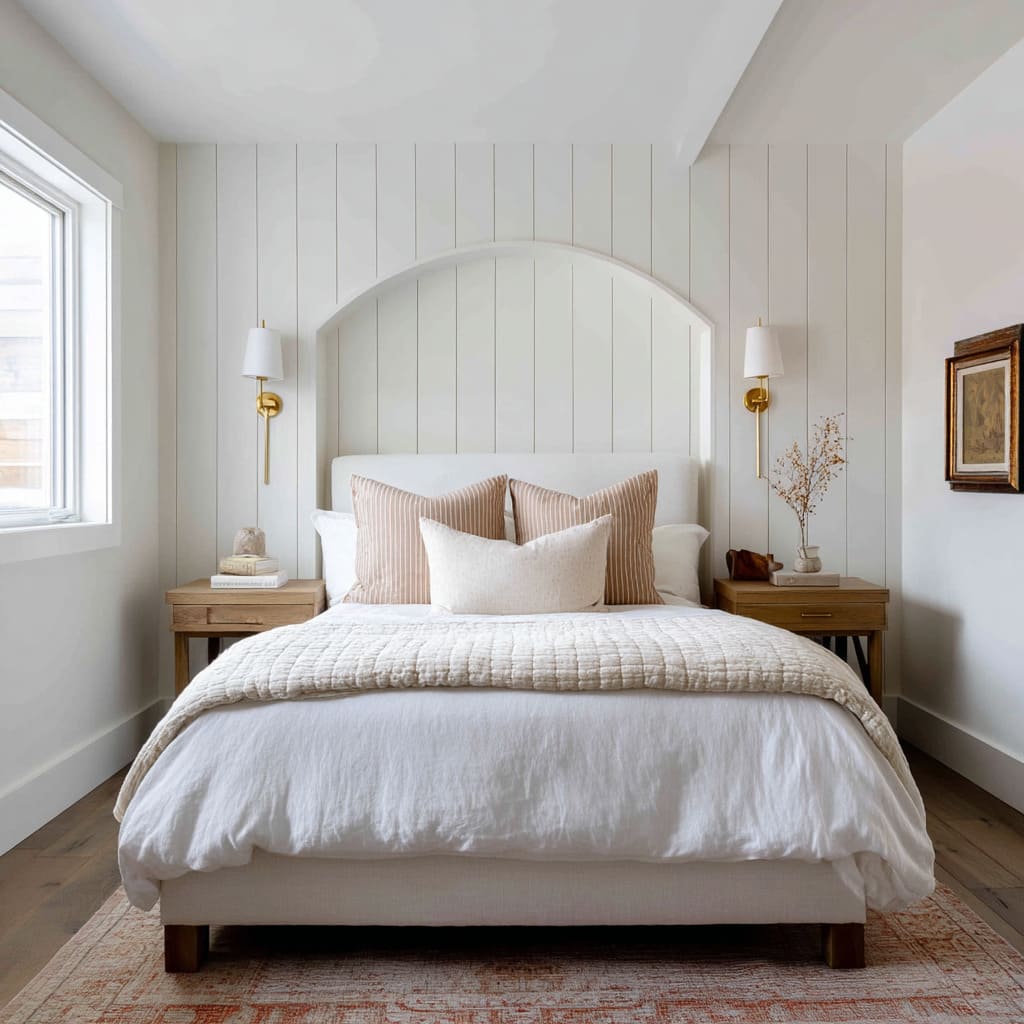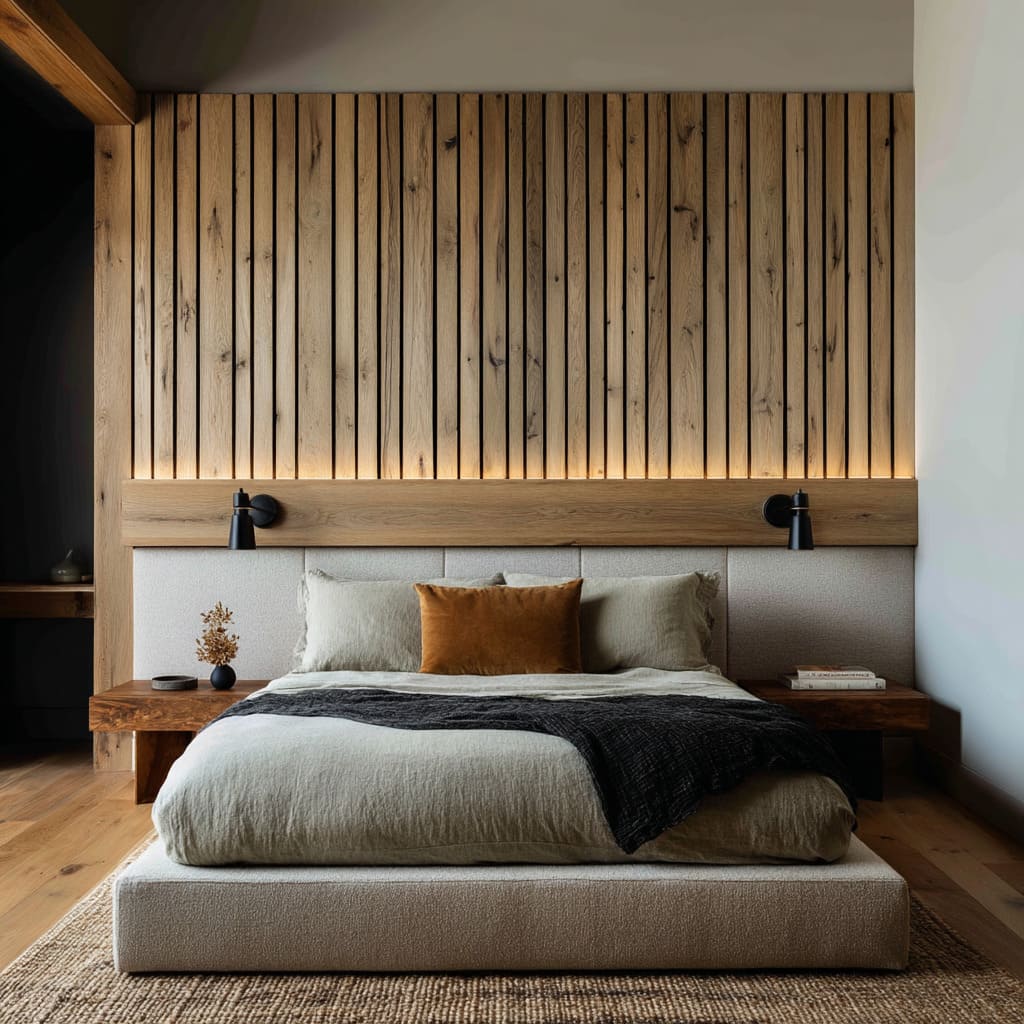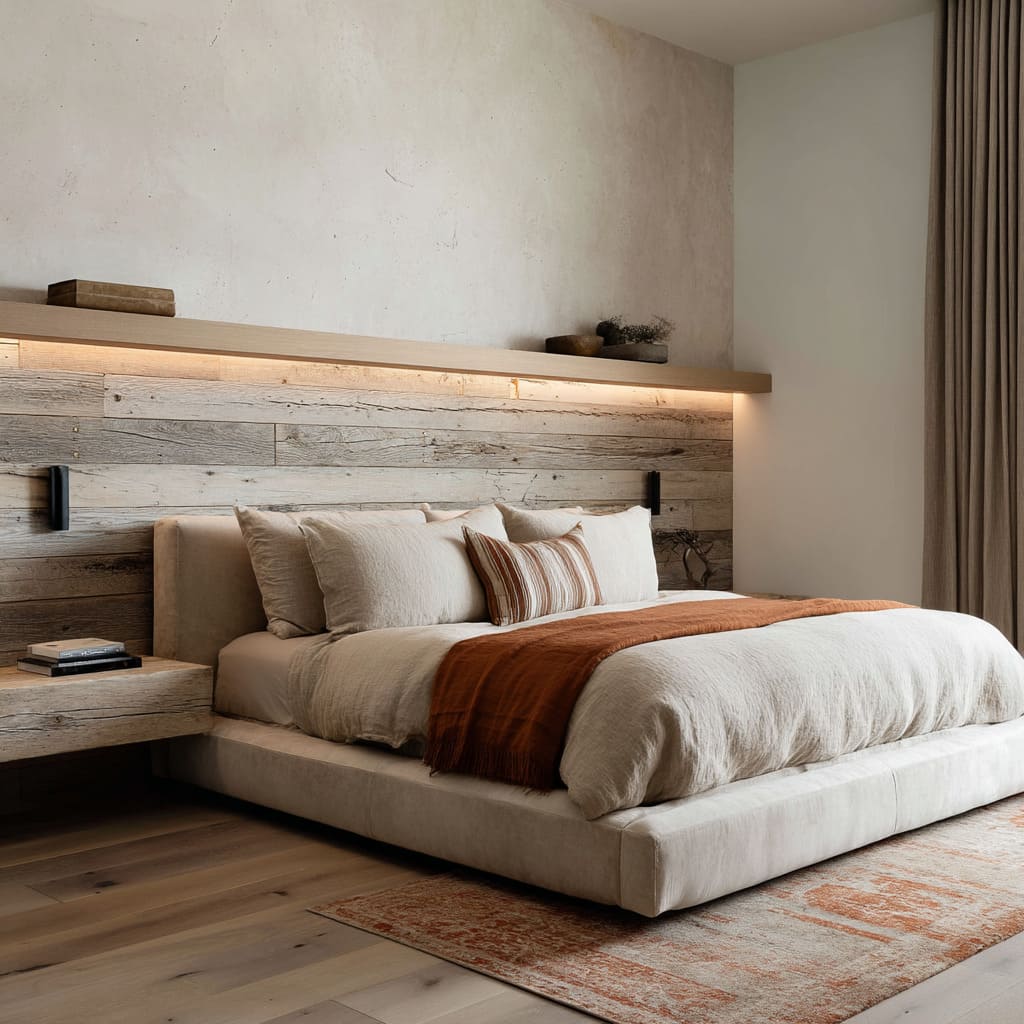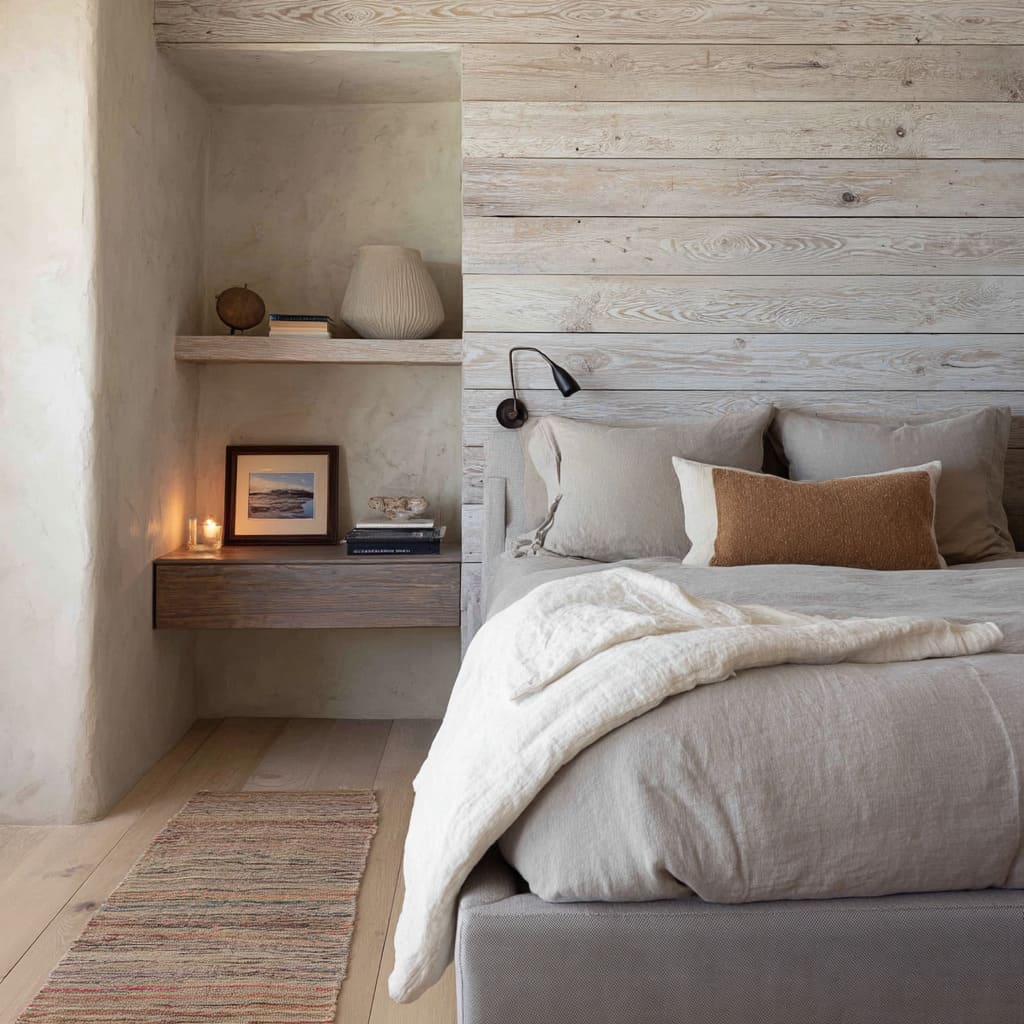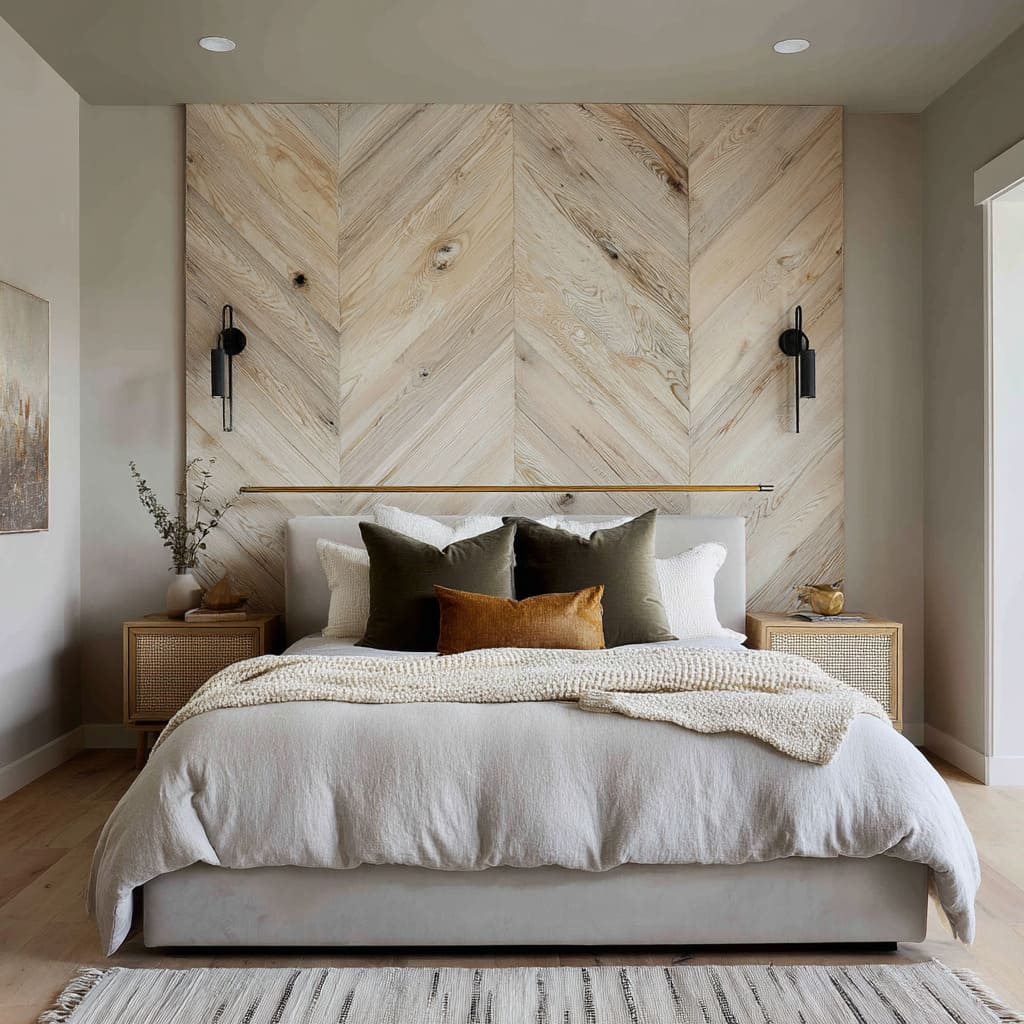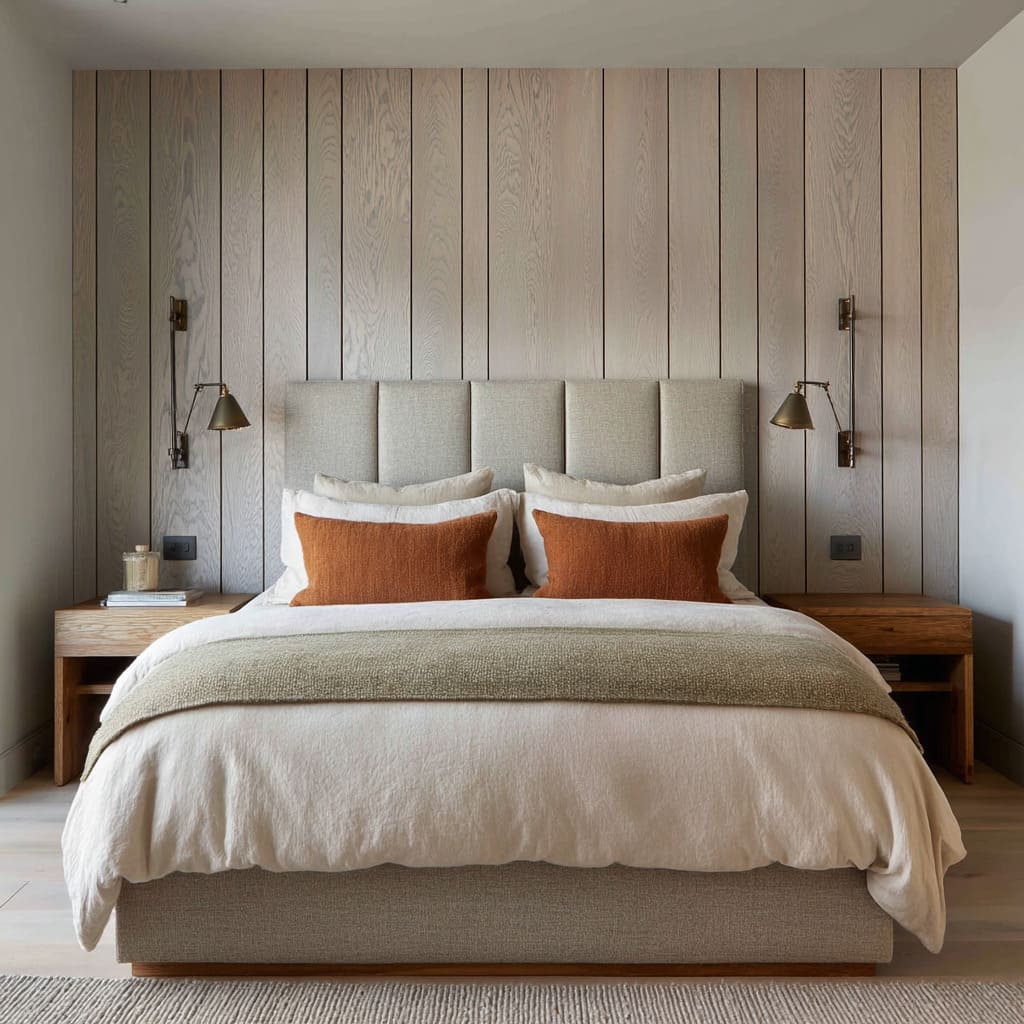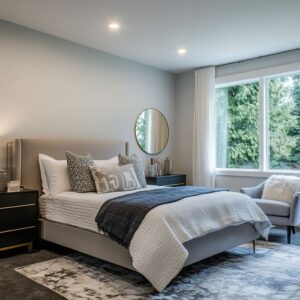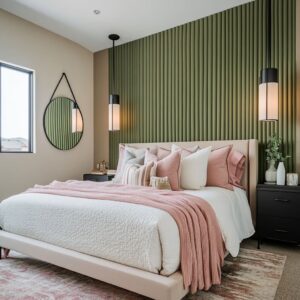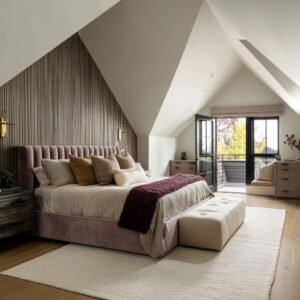Modern farmhouse bedrooms have shifted their attention from furniture toward full architectural surfaces—especially at the head of the bed. What was once a simple board tacked behind a mattress now unfolds into wood-clad alcoves, panel-wrapped niches, and quietly sculpted walls that fold light and texture into one continuous backdrop.
These aren’t rooms that rely on decoration to speak. They rely on form, proportion, and restraint.
Whether shaped by vertical oak slats, fluted fabric insets, or pale planks faded by soft daylight, the headboard becomes part of the architecture itself. And in the best examples, rustic material meets minimal structure—not through contrast, but through quiet alignment.
This article explores how grain, shape, tone, and even ceiling color are used to build atmosphere without a single loud gesture. Every surface becomes part of the structure’s mood.
Modern farmhouse headboards now behave more like quiet architecture than pieces of furniture
Today’s modern farmhouse headboard ideas aren’t content to simply sit behind the bed—they become part of the room’s entire structure. Rather than standing out as a separate element, the headboard wall folds into the surrounding space through intentional carpentry that plays with volume, alignment, and depth.
Some designs stretch upward until they touch ceiling beams, while others sink the bed into a box-like niche or soften its edges with a carved arch.
Grain direction, light flow, and architectural framing all contribute to the sense that the bed is being housed, not merely backed. What looks at first like a simple wood wall often turns out to be a layered backdrop—sometimes extending across the ceiling, sometimes framing alcoves or recesses that shape how the room is read.
The result is a kind of built-in quietness: where the bed is anchored in place not by hardware, but by proportion and enclosure. These rustic headboard ideas blend soft geometry with natural wood movement, letting structure lead the story while texture fills in the background.
The strongest visual code is a play between strict geometry and relaxed grain
One of the defining visual threads in modern farmhouse bedrooms is the way clean lines and natural variation meet in one surface. Whether it’s a run of bleached vertical planks, staggered mixed-width boards, or alternating blackened and raw slats, the repetition always carries a sense of rhythm.
These patterns are exact—but never cold. Grain direction shifts from one board to the next, adding a quiet irregularity.
Some headboard walls show faint saw marks or knots left intentionally exposed; others include reclaimed pieces with nail holes or weathered discoloration. This adds a kind of soft tension between the controlled layout and the untamed source.
The effect isn’t decorative in a traditional sense, but the combination of manmade order and natural irregularity brings a deep visual texture. Many of these rustic bedroom headboards use materials that feel aged but precise, structured but relaxed—drawing the eye not because of flash, but because of the way the wood breathes within the framework.
Contrast relies on material tone instead of bright color
Instead of bold paint or graphic prints, these spaces rely on the natural difference between materials to shape the scene. A warm pine plank wall may sit beside a deep charcoal upholstered headboard; blackened steel sconces appear against pale ash or silvery oak.
The contrast feels grounded because it’s built into the surface rather than layered on top. In some of the most refined setups, color appears in one or two small gestures—a rust-colored pillow, a soft olive throw, a piece of amber glass on a nightstand.
These limited accents break the neutrality just enough to bring depth, without distracting from the wood’s rhythm. Even within a palette that leans neutral, small changes in grain, finish, and fiber direction give the wall its tone.
This kind of layering keeps the focus on material rather than decoration, a hallmark of the most grounded rustic modern headboard compositions.
Light is treated as a painted wash, not a spotlight
In many modern farmhouse bedrooms, the way light is used feels almost like a quiet brushstroke rather than a direct beam. Instead of dramatic downlights or exposed bulbs that aim to call attention, these spaces rely on hidden LED strips and soft glows tucked behind wood edges or recessed niches.
One of the more common techniques involves lighting from within—strips hidden behind the top edge of a vertical slat wall, or uplighting that runs along a plank’s base—so the surface seems to emit light without showing its source. The result is that woodgrain appears lit from within.
Shadows fall gently between planks, emphasizing rhythm while avoiding hard lines. And since the lighting sits behind or below the surface, it shifts how the wall is perceived—taller when light glows upward, wider when it casts out softly from the lower edge.
The headboard wall becomes a plane of tone and texture, shaped in part by shadow and brightness. In many of the most refined rustic bed headboard ideas, the light doesn’t perform—it hums quietly in the background, redefining form through barely visible means.
Perfect symmetry is often nudged off‑center to keep the room from feeling staged
Even in layouts that follow balanced proportions, small shifts in placement keep the design from going flat. A pair of pendant lights might look evenly spaced at first, only to reveal one is slightly lower than the other, or a framed piece on the wall might interrupt a perfect grid of oak panels.
These aren’t mistakes—they’re calculated pauses in rhythm that make a space feel lived-in and layered.
Arched niches might be centered, but sconces are pushed a bit outward to open up visual breathing room. Even throw pillows, when stacked with intention but not rigidity, help soften a space filled with strong geometry.
These barely-there adjustments pull the space away from feeling staged. In many farmhouse headboard ideas, these imbalances are what make the difference between repetition and depth.
They’re small, but they ask the viewer to pause, to look again, to notice shape and distance rather than scanning through symmetry.
Surface honesty becomes the new luxury cue
Instead of coating everything in gloss or flattening grain with stain, many of these rustic wood headboard ideas let the material stay exposed, textured, and slightly imperfect. The best moments happen in the contrast between clean construction and raw surface—like a floating shelf made from reclaimed timber that still shows a curve or chip, or a wall of boards where the knots seem to catch light just enough to highlight them.
These details aren’t mistakes—they’re the visual proof that the material was selected for character. Beams with visible splits, edges that don’t square off completely, or natural warping left untouched all signal the same idea: precision isn’t always about perfection.
It’s about knowing what to leave in. Whether used in planking behind a bed or in the nightstand beside it, this treatment gives the space warmth without adding decoration.
It feels finished because the wood has been respected, not overworked. In this sense, rustic texture becomes a design tool, not a nostalgic gesture—holding its own even in spaces that otherwise lean minimal.
Soft textiles provide relief through thickness, not pattern
In bedrooms where wood panels and structured lines take the lead, fabric steps in not to decorate—but to soften. The textures found in these modern farmhouse headboard settings are usually quiet, but physically present.
Upholstery in stone-washed bouclé, thick linen, or soft tweed is chosen for how it holds shape, not for bold prints. A simple vertical channel, a ribbed pad, or a densely woven surface creates a slow rhythm that doesn’t compete with the grain behind it.
In many setups, the fabric acts like soundproofing for the eyes—absorbing the angular noise of chevron planks, board-and-batten, or tight slat patterns. Since the wall itself already carries the energy, the bedding and headboard remain subtle, letting depth come from weave density, not color.
This creates a layered hush where volume is measured in texture rather than design elements. A well-placed modern farmhouse headboard, wrapped in thick neutral fabric, becomes an anchor—not by standing out, but by being physically felt in the softness it adds to the structure-heavy space.
Curves and arches introduce a gentle counterpoint in a world of planks
While most farmhouse walls lean into straight lines and vertical direction, the quiet presence of a curve can reset the mood. An arched headboard niche, a rounded cut into cladding, or a soft-radius shelf edge gives a break in the visual momentum.
It’s a pause, not a statement. These arcs echo the softened shapes once found in barn windows or timber archways—but here, they are stripped down to pure shape.
Shadow alone outlines them. A curve built into an otherwise squared space introduces a touch of balance—like a breath held between rows of vertical boards.
The curve doesn’t need to be large or dramatic. Even a slight bend in the headboard surround can shift the feeling of the room, pulling tension away from the rigid lines of a wall built from straight planks.
This is where a subtle rustic headboard design becomes interesting—not because of contrast in color, but because of the conversation between form and texture.
Framing devices quietly showcase negative space
Rather than adding more elements, many of these bedrooms use frames—not to decorate, but to direct. An oak-lined surround, a boxed-in ceiling niche, or a recessed wall shelf serves as a visual boundary that sets off the bed like a quiet display.
These frames aren’t ornamental. They act like margins around the composition—helping the eye know where to rest.
In some rooms, a wood portal outlines the sleeping area in a soft enclosure; in others, floating nightstands and suspended pendants hang slightly away from the wall, leaving a slim line of air between furniture and backdrop. This negative space—often only a few inches—is what keeps the surface legible.
Especially in rooms with dark wood or closely spaced slats, allowing a bit of visual breathing room makes the design feel precise, not crowded. These techniques allow rustic bedroom headboards to sit comfortably inside their own structure, framed not with trim, but with air and alignment.
Local atmosphere guides palette and grain choice more than theme does
Wood selection and fabric tones in farmhouse style bedrooms are often shaped by the surrounding climate rather than a fixed style guide. The way a wall reads in early morning fog differs from how it reads under high desert sun.
In cooler mountain regions, designers lean into planks with ashy finishes or driftwood undertones—tones that echo the natural light filtered through pine trees or snow-heavy skies. In drier zones, pale whitewashed pine or sun-softened oak tends to reflect the chalky soil and the bleached warmth of late afternoons.
Even when two rooms share similar forms—like vertical planks or fluted upholstery—the difference in grain direction or surface tone often points back to the regional light. Rather than impose a single interpretation of farmhouse interiors, these spaces let temperature, altitude, and geography shape the tone.
It’s an approach that keeps the room visually grounded, and it’s why country style headboard ideas rarely look the same between places like Northern California, rural Utah, or quiet hill towns in the Midwest. The backdrop adjusts—not by changing the structure, but by letting the grain and hue match what’s outside the window.
Weathering is used to suggest time even in new construction
Even in freshly built rooms, the sense of time passing is part of the visual language. This isn’t about fake aging—it’s about how materials are allowed to hold their marks.
A slightly silvery plank, a chalky coat of paint that shows wood texture underneath, or boards reclaimed with their soft gray edges intact—these gestures carry a quiet sense of age. They don’t pretend to be old, but they hold on to traces of life.
The sharp lines and joinery are still precise, but the surfaces feel softened by intention. This keeps the look steady—never antique, never glossy.
The best farmhouse interiors often walk that line between fresh and familiar, letting modern shapes carry rustic finishes. It’s this balance that gives a newly built room its settled atmosphere.
Some spaces use these signs of wear to take the edge off symmetry; others use them to warm up a palette that would otherwise feel too crisp. Either way, the worn textures do more than decorate—they slow the space down, grounding it without relying on nostalgia.
Depth is often gained by layering thickness instead of adding objects
Rather than filling the space with extras, these bedrooms often build interest by adjusting how the surfaces move. A slightly raised fabric panel, a recessed wood border, or a stepped slat wall can do more for depth than a cluster of accessories.
The wall itself carries the volume. Thin bouclé squares tucked into oak grids, narrow headboards framed by a subtle ledge, or panels that break projection by half an inch—all of these shifts give the illusion of layers.
Light responds to the variation in thickness, creating soft shadow pockets where flat paint or flat boards would fall silent.
In farmhouse settings, where the palette tends to stay low contrast, this kind of relief becomes essential. It’s also why many walls in these rooms feel sculpted, even when they don’t show a single piece of art.
Texture lives in the construction. In a space shaped by grain, fiber, and proportion, depth comes from surface topography—not from décor.
This technique keeps the visual weight within the architecture, letting the wall itself do the work. It’s a quiet but lasting approach that defines many of today’s farmhouse interiors.
Subtle metallic accents punctuate wood without stealing focus
In rooms where wood takes center stage, small glints of metal serve as quiet punctuation marks. These aren’t flashy finishes meant to grab attention—instead, they catch light gently, offering a break in the continuity of timber.
A brushed brass ring at the neck of a wall sconce, a wafer-thin steel ledge beneath a framed panel, or pendants bound in natural rope with exposed hooks—all of these show how metal, when used sparingly, behaves more like a pause than a headline. The tone matters too: muted brass, blackened bronze, and aged nickel tend to echo candlelight more than mirror it.
Their presence doesn’t compete with grain or upholstery; it holds space between materials. This kind of detail brings precision without pushing the mood too far into polish.
A burnished finish tucked against pale oak or reclaimed plank gives just enough edge to feel contemporary without shaking the rustic base. In farmhouse interiors where everything leans grounded and tactile, this type of metalwork adds clarity—like a breath between long phrases of wood and fabric.
Color accents cluster low, pulling visual gravity toward the sleeper
In most of these farmhouse bedrooms, the richest colors are rarely found on the walls. Instead, they gather close to the mattress—forming a soft anchor for the eye.
A burnt ochre lumbar pillow, an olive-toned knit, or a cinnamon wool throw helps root the bed within the surrounding space. These shades tend to fall within the earth spectrum—deep but muted—so they never overwhelm the backdrop.
This lower placement of color plays a visual trick: by keeping stronger hues near the bed, the upper sections of the room stay light, even if they’re clad in dark or heavy materials. The contrast is subtle, but it changes how the space reads.
The bed becomes the center of warmth and density, while the walls remain breathable. In some rooms, this move echoes natural shadow fall, where weight settles near the ground.
In others, it offsets wood cladding that might otherwise feel visually top-heavy. It’s a rhythm often used in both modern and country-inspired farmhouse style interiors—pulling emphasis downward while letting materials above stay open, tonal, and undisturbed.
The most hidden move is the use of ceiling tone to steer perception
One of the quietest yet most effective ways to shape a bedroom is through the ceiling’s tone. It’s not the first thing noticed, but its effect lingers in how the space feels.
A ceiling painted in charcoal, for example, can mute reflected light just enough to deepen the surrounding materials. Wood slats below it take on a richer tone; contrast becomes warmer and less stark.
On the other hand, when the ceiling echoes the pale plank cladding of the walls—especially in a whitewashed or driftwood finish—the vertical space stretches. Height feels exaggerated, even in modest rooms.
This visual cue works without any need for extra decoration or architectural changes. By adjusting the ceiling’s depth of color or texture, designers shift how the room is read—raising or lowering the weight of the space in subtle degrees.
It’s a move that stays in the background but quietly determines the balance between openness and enclosure. And in spaces where every surface is already pulling visual duty, this kind of adjustment from above is a way to control tone without adding objects.
Everything unnecessary is carved away, letting grain, gap, and glow tell the story
What defines many of today’s farmhouse bedrooms is not what’s placed in the room, but what’s left out. Visual silence is achieved by removing anything that doesn’t serve a structural or textural role.
Handles disappear into edge pulls. Brackets vanish behind floating shelves.
Decorative clutter gives way to a single seed stem in a matte vase or a stack of books with their spines turned inward. These moves aren’t about austerity—they’re about focus.
What’s left is the rhythm of plank spacing, the direction of fabric grain, and the way hidden lighting grazes a wood surface just enough to bring out the pores. In this environment, contrast isn’t loud—it’s found in the tension between soft and raw, matte and fibered.
A wool-upholstered headboard floats in front of bleached wood. A darkened metal sconce cuts a clean silhouette against vertical oak slats.
Minimalism in this setting doesn’t erase warmth—it clears space so that texture becomes readable. It’s here that farmhouse and restraint meet, proving that richness doesn’t require more—just the right mix of light, material, and room to breathe.
Conclusion
In most ideas, the headboard disappears as a standalone object and instead becomes part of the structure shaping the room. Light is drawn into panels and frames; wood gains rhythm through spacing and surface treatment; and fabric earns its place through volume, not color.
Instead of layering more, these spaces subtract—letting raw timber meet soft boucle, letting air gaps carry as much weight as décor, and letting shadow fall where design has made room for it. The effect is subtle but deeply deliberate.
In the world of modern farmhouse bedrooms, the quietest surfaces are often doing the most.
